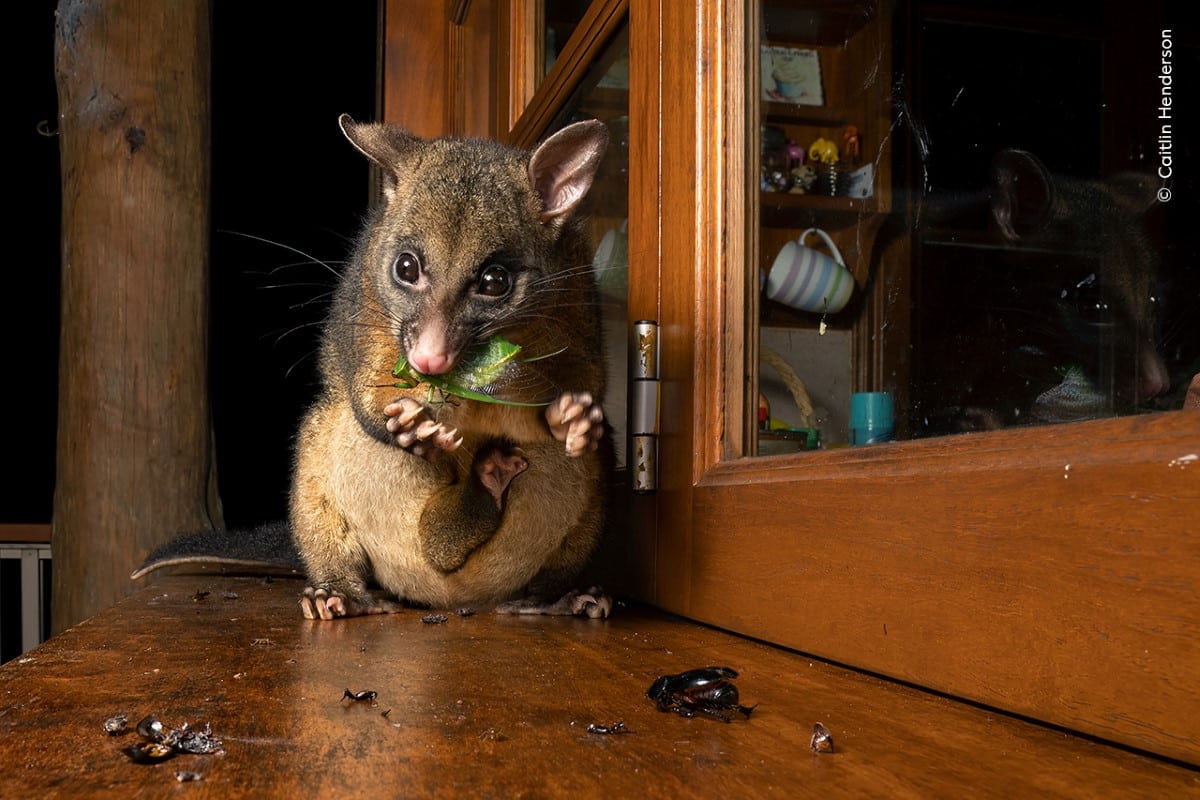
“Possum’s midnight snack” by Caitlin Henderson, Australia. Highly commended, Urban Wildlife.
Location: Malanda, Queensland, Australia
“Caitlin Henderson finds an unexpected guest on her balcony as a possum snacks on a large cicada. ‘There were heads here, wings there,’ Caitlin says. She had peeked out and spotted a common brushtail possum sitting on the windowsill. Quick reactions allowed Caitlin to photograph the possum hungrily dismembering a large northern greengrocer cicada while carrying a baby in its pouch. This nocturnal marsupial, native to Australia, is widespread and locally abundant. Its long, sharp claws are made for a life in the trees, but it has readily adapted to urban environments and come into conflicts with humans.”
A possum eating a tasty midnight snack, a leopard deftly crossing a river, and a bee quietly building its nest are just some of the animals featured in photos from the 59th Wildlife Photographer of the Year competition. These highly commended images are just some of the 100 magnificent photos from the contest that will be included in an exhibition at London’s Natural History Museum.
The exhibit, which opens October 13, caps a stellar year for the contest, which saw 49,957 entries from photographers hailing from 95 countries. While the category and overall winners will be announced on October 10, these finalists are a testament to the talent that enters this prestigious contest.
Among the newly released highly commended images is an unusual interaction of a macaque jumping on a deer photographed by Atsuyuki Ohshima, and the drama of a snow leopard hunting a Pallas’s cat witnessed by Donglin Zhou. Michał Siarek records the hopeful moment a team opens a crate to check on a tiger cub evacuated from Ukraine, and Jasper Doest shares the heart-wrenching story of an elephant struck by a train in Gabon.
“What most impressed the jury was the range of subjects, from absolute beauty, rarely seen behaviors and species to images that are stark reminders of what we are doing to the natural world,” shared judging chair Kathy Moran. “We felt a powerful tension between wonder and woe that we believe came together to create a thought-provoking collection of photographs.”
Once the exhibition ends its run at the National History Museum in June 2024, it will embark on a UK and international tour, allowing millions to see these important testimonies of the natural world.
The Natural History Museum’s Wildlife Photographer of the Year contest has released a preview of its finalists.
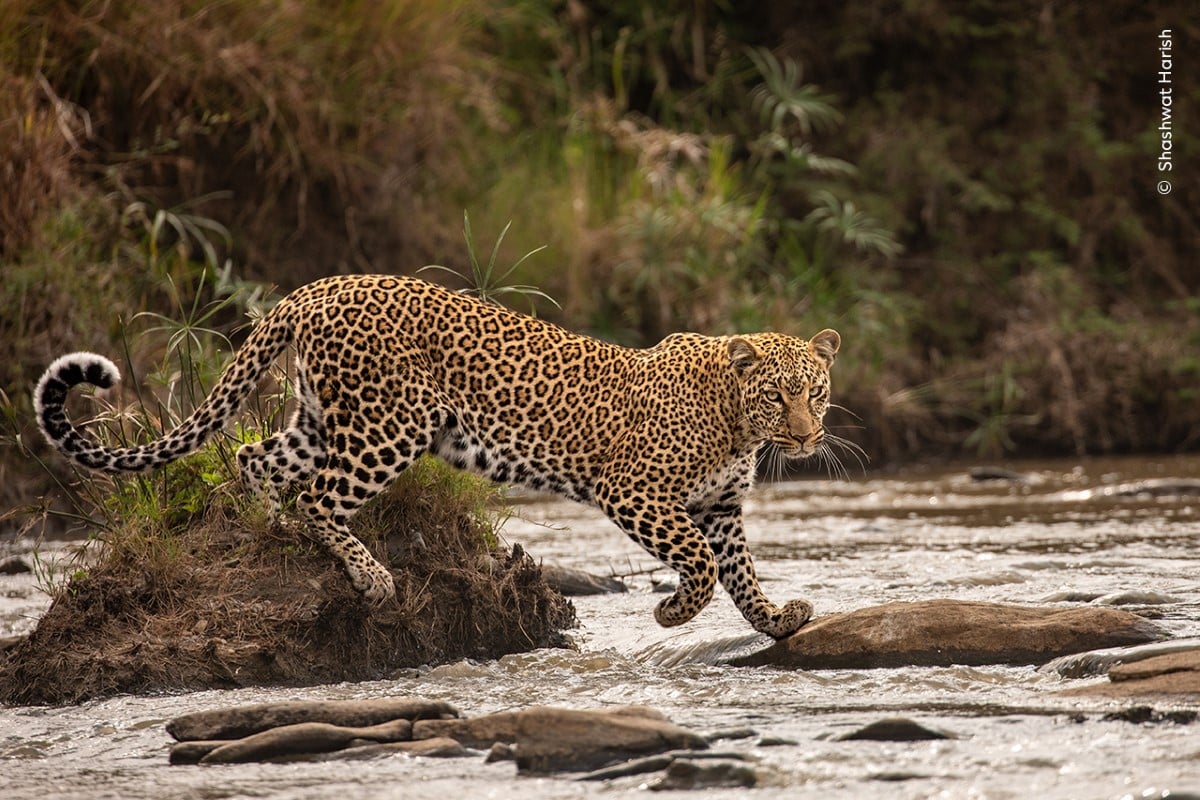
“The catwalk” by Shashwat Harish, Kenya. Highly commended, 11-14 Years.
Location: Maasai Mara National Reserve, Narok, Kenya
“Shashwat Harish is rewarded for his patience with a moment of eye contact and the curl of a leopard’s tail.
Shashwat was on a trip to the Maasai Mara when he heard that a leopard had been spotted nearby. After he spent many hours in a vehicle, searching and waiting, the leopard appeared, and Shashwat quickly changed lenses and settings to obtain this elegant portrait. Leopards are the smallest of the big cats, and they are often seen near water in the Maasai Mara. Population numbers are decreasing due to habitat loss, hunting, and the decline of their prey.”
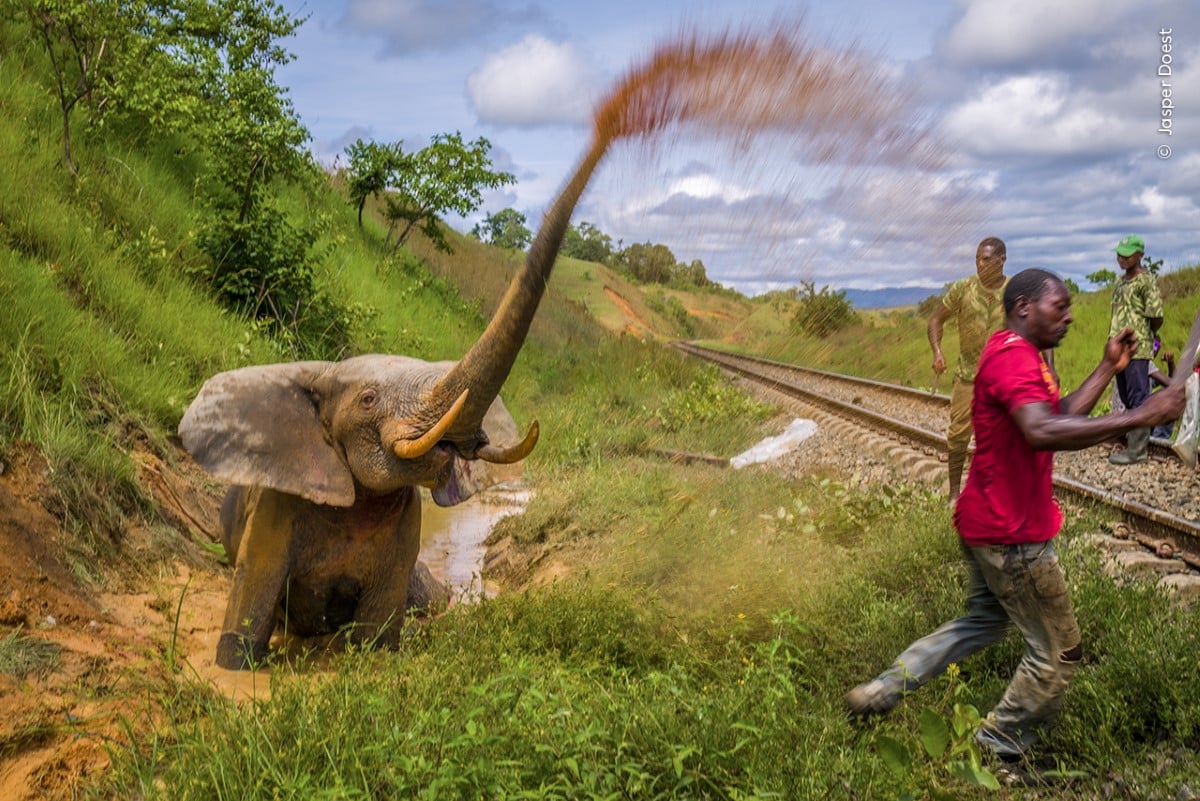
“Fight to the death” by Jasper Doest, the Netherlands. Highly commended, Photojournalism.
Location: Lopé National Park, Gabon
“Jasper Doest (the Netherlands) shows the final moments of extreme distress felt by an elephant hit by a train.
The collision shattered the elephant’s hip beyond repair, and it had to be killed. Jasper, who was in the park on a different assignment, witnessed the episode. Despite the park director’s efforts to get the train company to slow trains, there are regular wildlife–train collisions in Lopé National Park, including up to 20 incidents with elephants a year. Trains transport manganese from the Moanda mine, which holds 25% of known reserves. Manganese is a metal used in iron and steel production.”
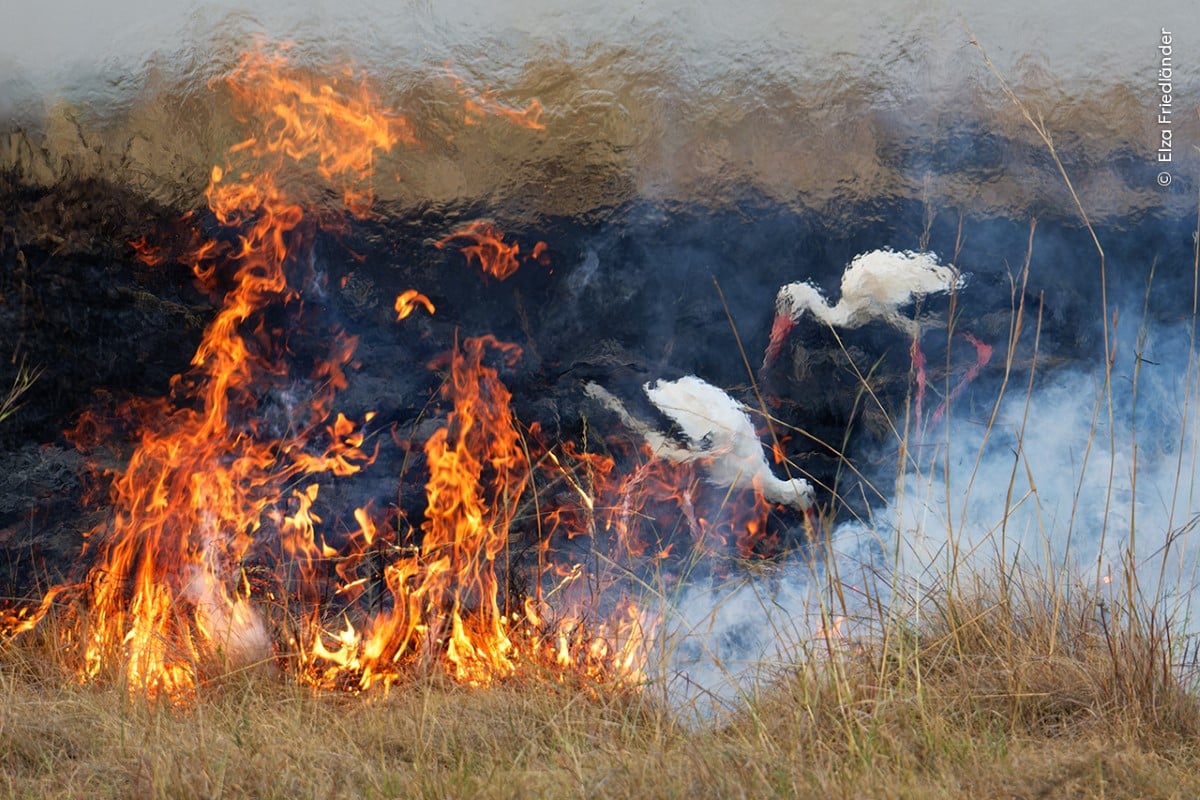
“Firebirds” by Elza Friedländer, Germany. Highly commended, Behaviour: Birds.
Location: Rhino Ridge, Maasai Mara National Reserve, Kenya
“Elza Friedländer shows a pair of white storks in shimmering heat against the burnt ground caused by a controlled fire.
As Elza had anticipated, shortly after the controlled fire was lit on an area of Kenya’s Maasai Mara, hundreds of birds arrived, particularly storks and kites. Most kept a reasonable distance, but the storks pressed up to the front line in search of easy prey. Starting fires is a common though controversial way of managing grasslands to stimulate lush new growth and to control the spread of bushland. This can be a dangerous tactic, especially in times of drought when fire spreads easily.”
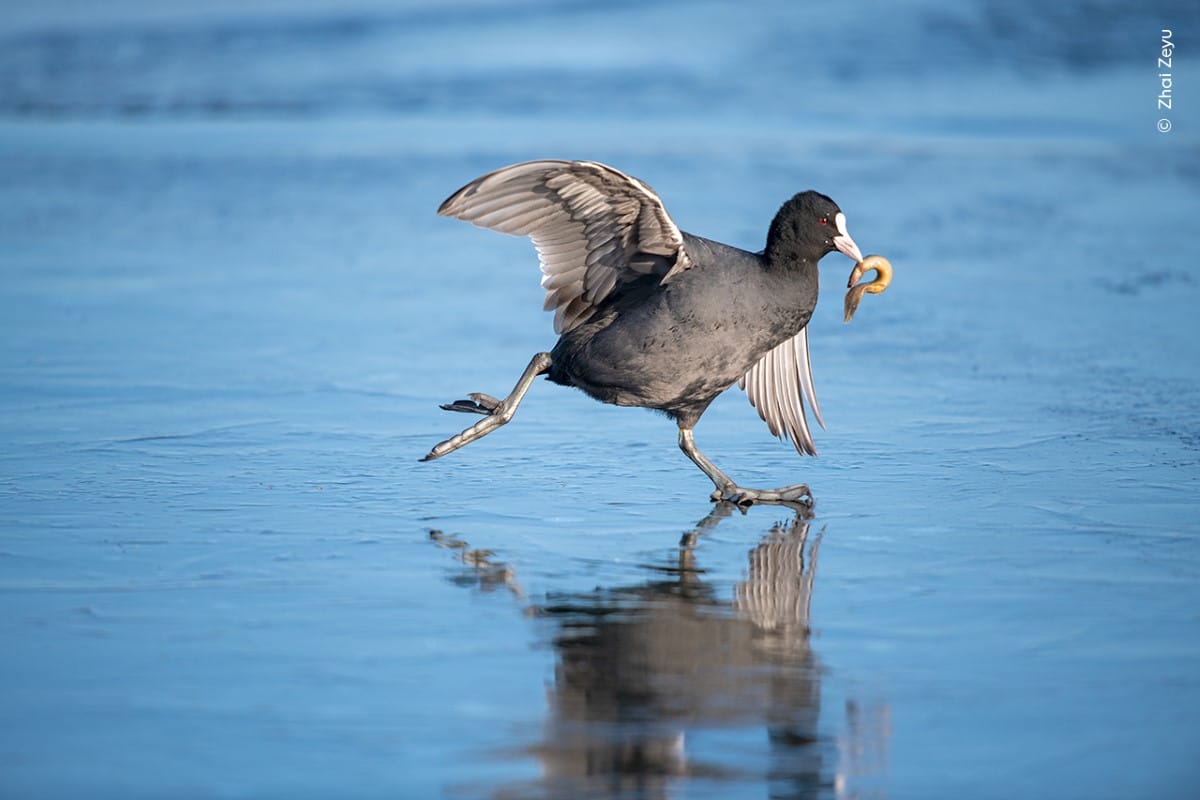
“Coot on ice” by Zhai Zeyu, China. Highly commended, 10 Years and Under.
Location: Dalian, Liaoning, China
“Zhai Zeyu enjoys watching a coot as it struggles to stay upright on ice while subduing a wriggling loach.
Zhai waited in the cold, watching coots as they endeavored to move across a frozen pond in northeast China. This coot had been scrambling in the water for food and eventually caught a loach. Common coots are among the most widespread birds, with a range that extends across Europe and Asia and into North Africa and Australia. They require large areas of open water with nearby cover for nesting, and populations can be affected when their habitat is disturbed by humans.”
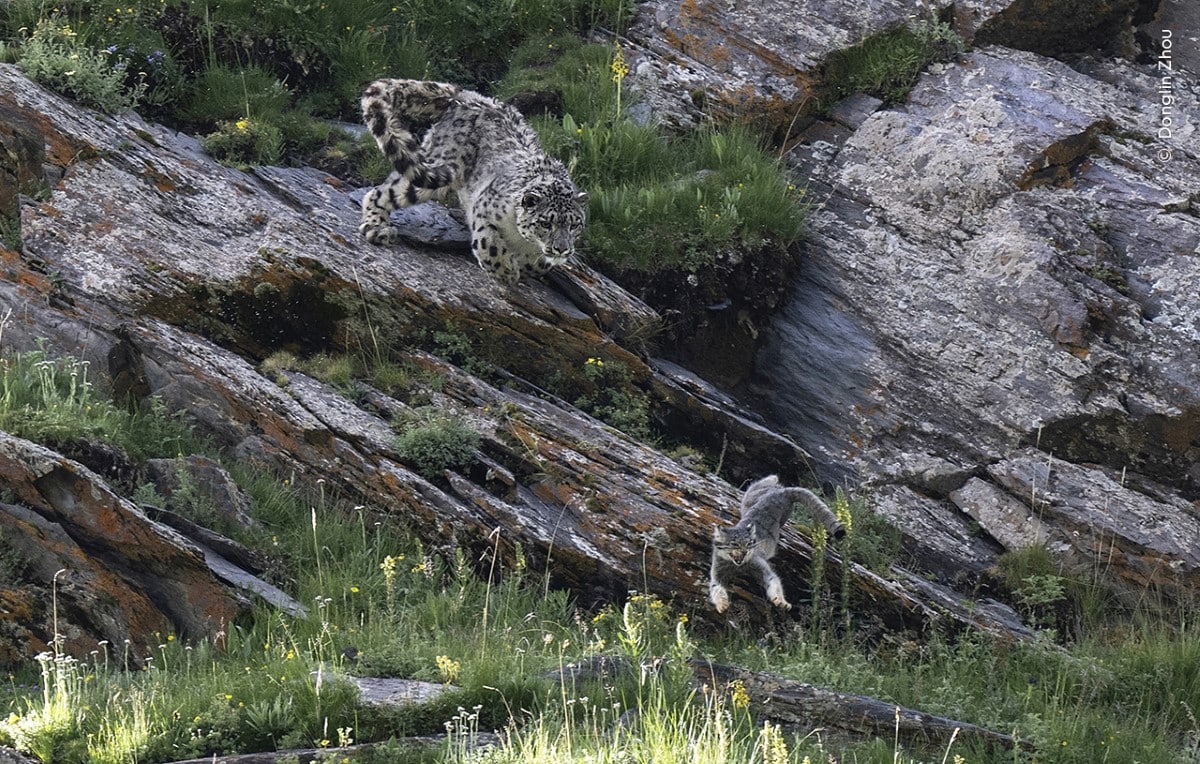
“Race for life” by Donglin Zhou, China. Highly commended, Behaviour: Mammals.
Location: Gayi, Sichuan, China
“Donglin Zhou witnesses the drama of a snow leopard hunting a Pallas’s cat.
When the snow leopard sprang into action, Donglin assumed it was after a marmot as ‘the Pallas’s cat blended in so well with the rocks.’ But in less than a minute, it was in the snow leopard’s jaws. Both species are well camouflaged and are hard to see at any time, let alone together. While large birds of prey and wolves are known to hunt Pallas’s cats, it is a rare sight to see them hunted by snow leopards.”
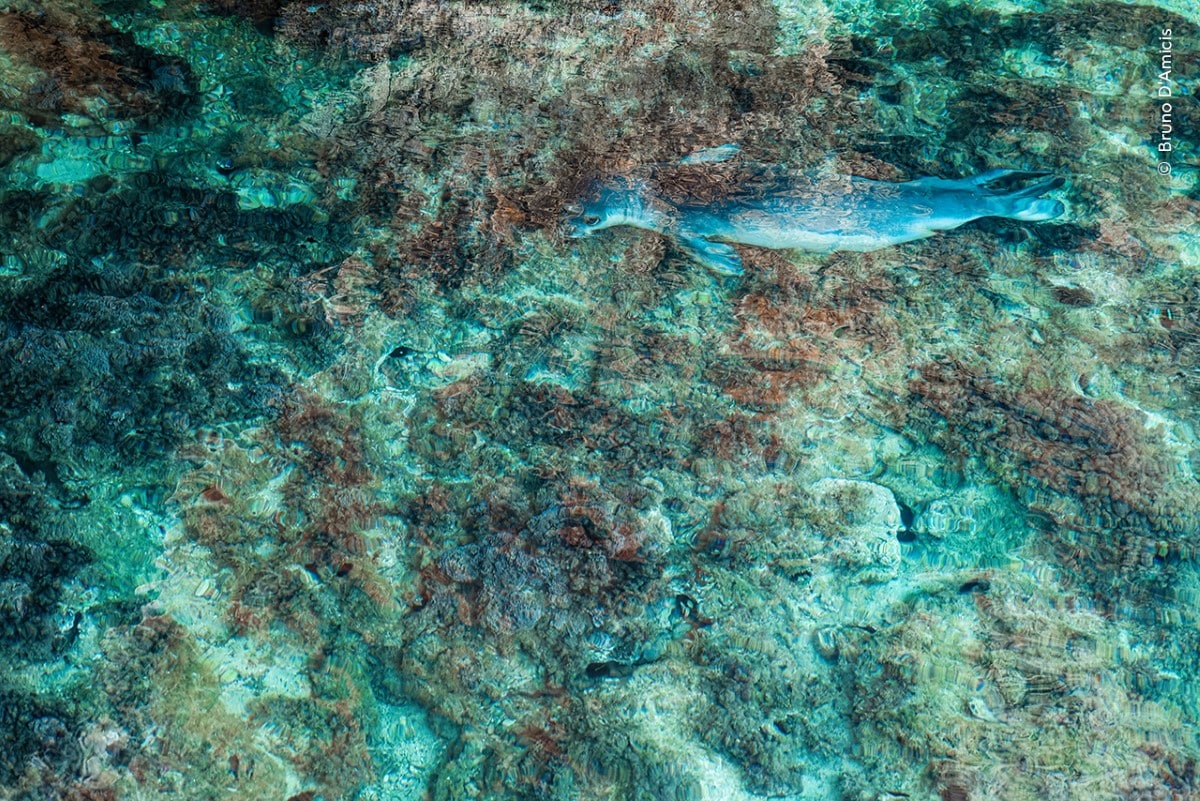
“The vanishing seal” by Bruno D’Amicis, Italy. Highly commended, Natural Artistry.
Location: Greece
“Bruno D’Amicis is rewarded for his perseverance with a mosaic-like image of a Mediterranean monk seal.
Working under permit, Bruno lay hidden on a ledge for several hours before a Mediterranean monk seal glided through the shallows and disappeared into a cave below. The reflections on the water helped hide this elusive seal and allude to the risk of the species totally disappearing. This species is now one of the most endangered mammals on Earth due to historic hunting and human encroachment on its habitat. Mediterranean monk seals once rested on open beaches, but most now seek the safety of caves.”
These highly commended photos were selected from the nearly 50,000 images that entered the prestigious contest.
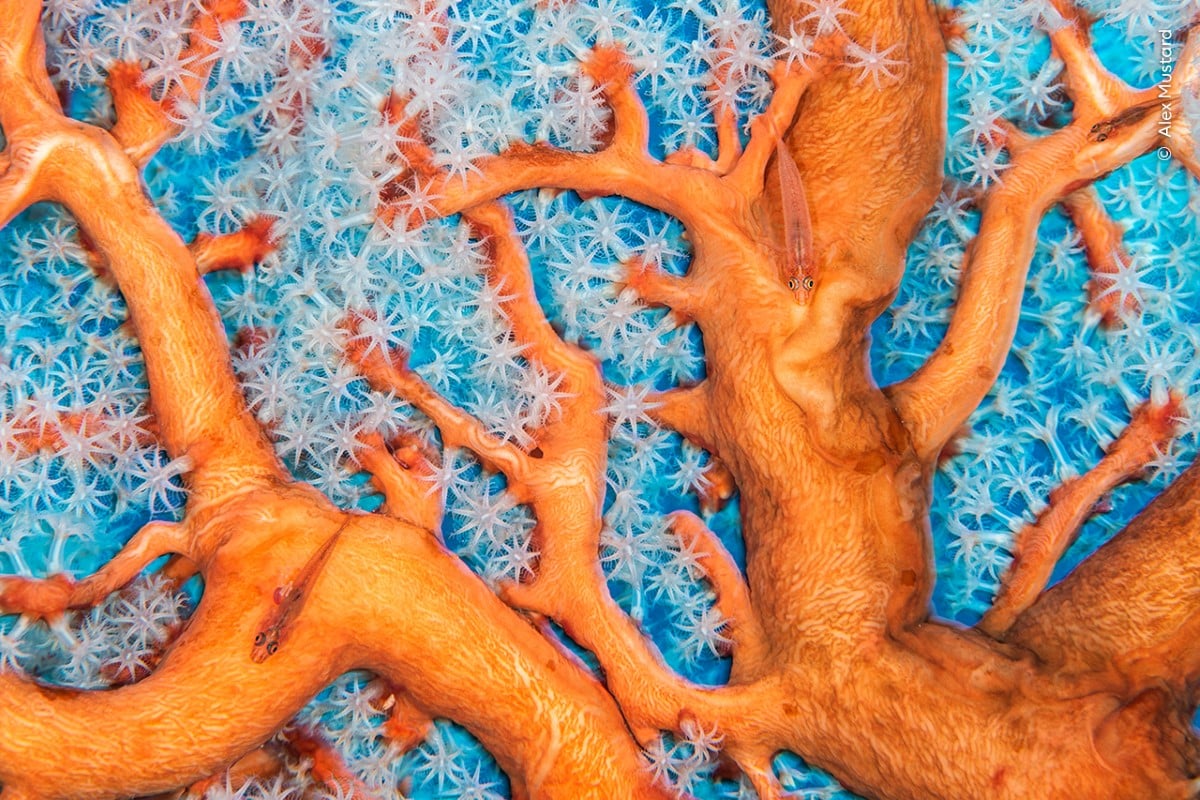
“Coral connections” by Alex Mustard, UK. Highly commended, Under Water.
Location: Lembeh Strait, North Sulawesi, Indonesia
“Alex Mustard shows the biodiversity of a healthy coral reef as ghost gobies swim within the branches of a sea fan.
Alex is particularly fond of gobies, which are normally skittish, but he was determined to picture more than one in the frame. Unexpected was the copepod parasite on one fish. Capturing the vibrant, contrasting colors meant holding steady in the current to get a long enough exposure. Ghost gobies use gorgonian sea fans as a refuge or feeding platform and perfectly blend into their surroundings. Coral reefs support a diversity of interconnected species but are at risk due to the warming seas of climate change.”
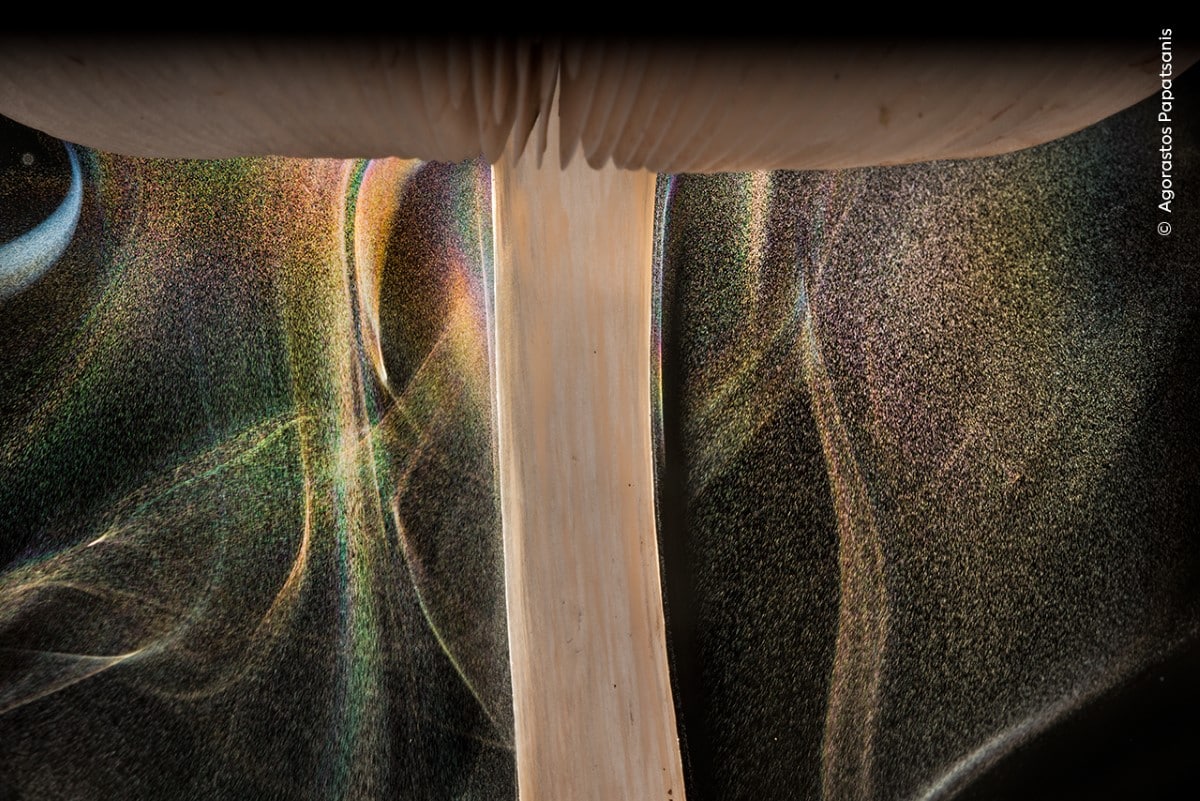
“Mushroom magic” by Agorastos Papatsanis, Greece. Highly commended, Plants and Fungi.
Location: Mount Olympus, Pieria, Greece
“Agorastos Papatsanis illuminates swirls of spores appearing to dance beneath the gills of a deer shield mushroom.
Intent on revealing the magic of spore dispersal, Agorastos set up umbrellas to minimize airflow, positioned a light and a reflector, and angled his camera to highlight this often-unseen action as waves of ethereal dust. Billions of these tiny egg-shaped spores are dispersed by air currents. This wood-rotting fungus most often emerges on the stumps and fallen branches of broad-leaved trees.”
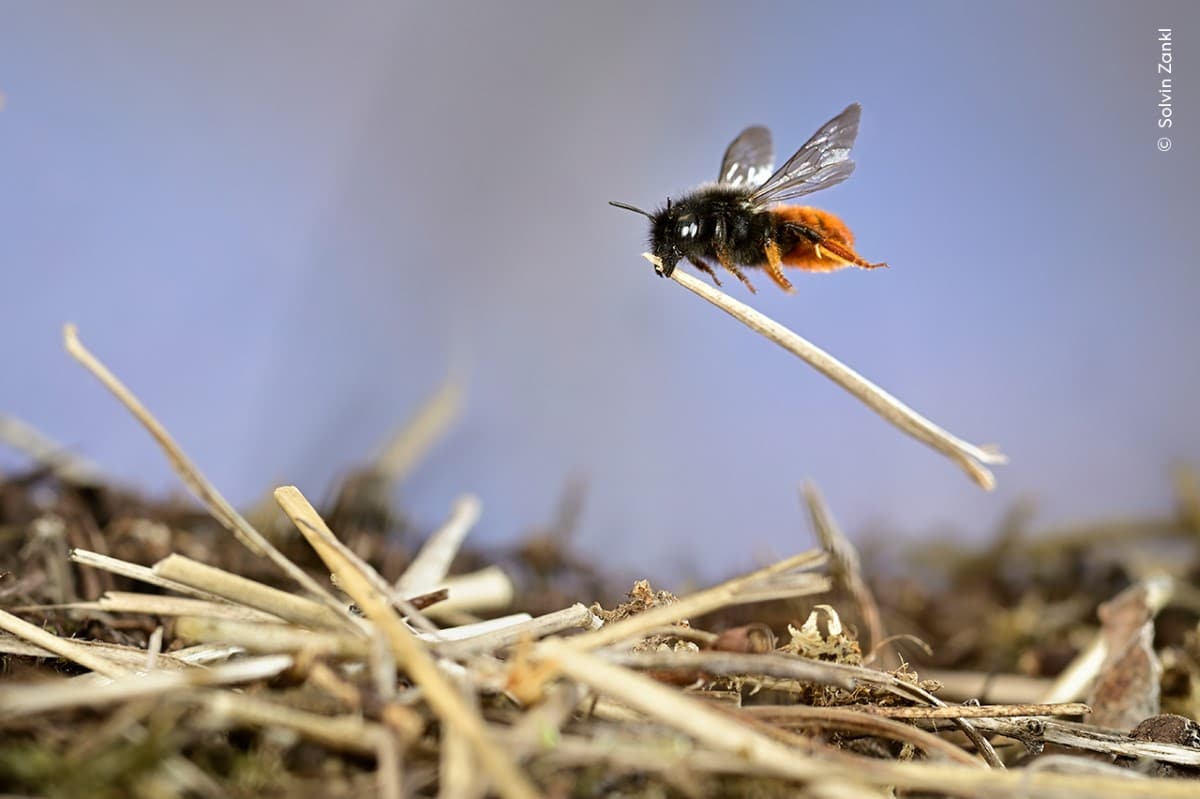
“Mason bee at work” by Solvin Zankl, Germany. Highly commended, Behaviour: Invertebrates.
Location: Near Witzenhausen, Hesse, Germany
“Solvin Zankl carefully watches a two-colored mason bee build the roof of its nest.
Solvin knew the bee was memorizing landmarks around the nest so it could find it again. So as not to disorientate it, he edged his equipment closer each time it left. After two hours, the bee was using his equipment as a landmark. Two-colored mason bees use snail shells for egg-laying. They pack the shell with pollen and nectar for their larvae, then seal it with grass and sticky saliva. Humans sometimes consider snails to be pests, but this species could not survive without them.”
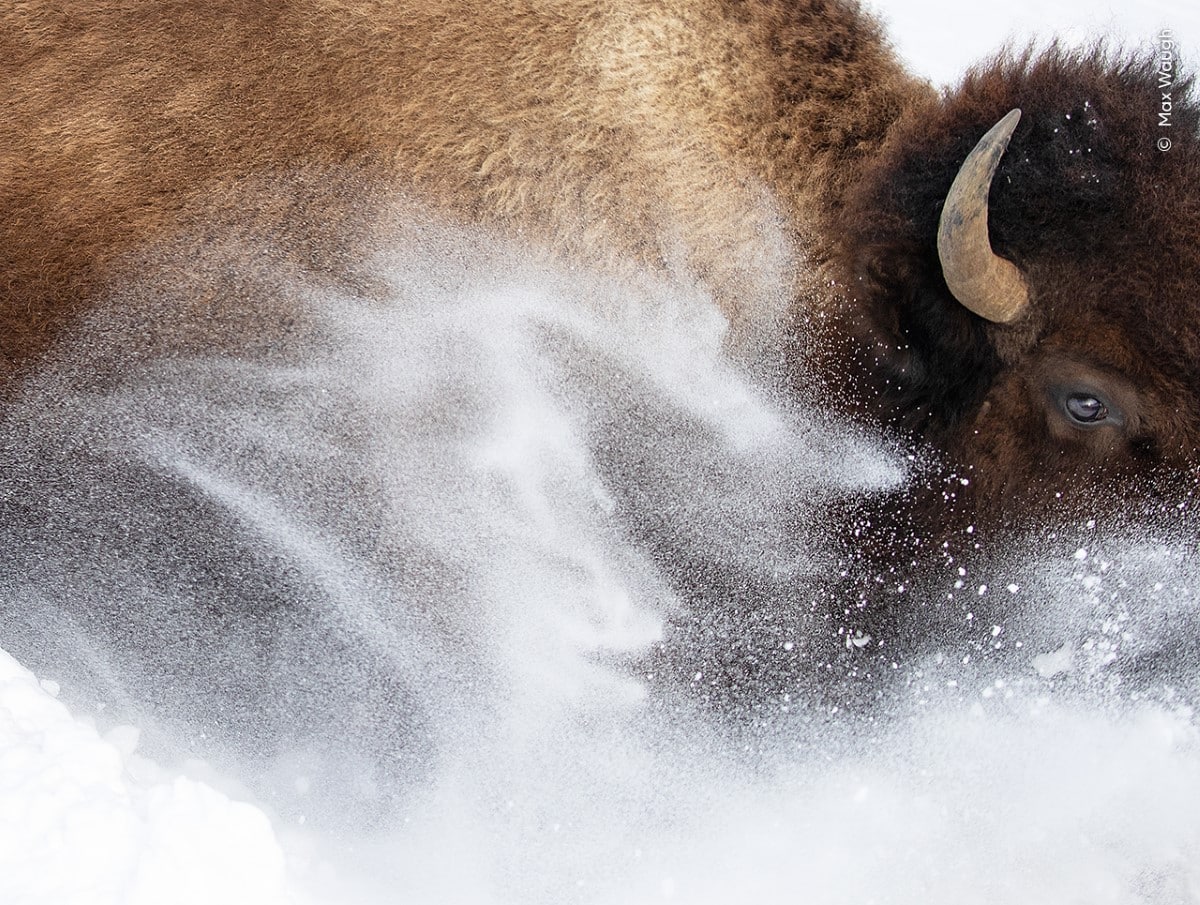
“Snow bison” by Max Waugh, USA. Highly commended, Animal Portraits.
Location: Yellowstone National Park, Wyoming, USA
“Max Waugh catches sight of a plains bison kicking up flurries of snow over its bulky frame.
From his vehicle, Max saw the bison start to head downhill towards the road, gathering momentum, and he drew up to give them space to cross. Max framed the bison tightly to create this original composition. Once abundant and wide-ranging across most of North America, bison were hunted to near extinction by the late 1800s. Numbers are slowly increasing, but they are confined to discrete populations, dependent on conservation management and constrained by land-use changes and land ownership.”
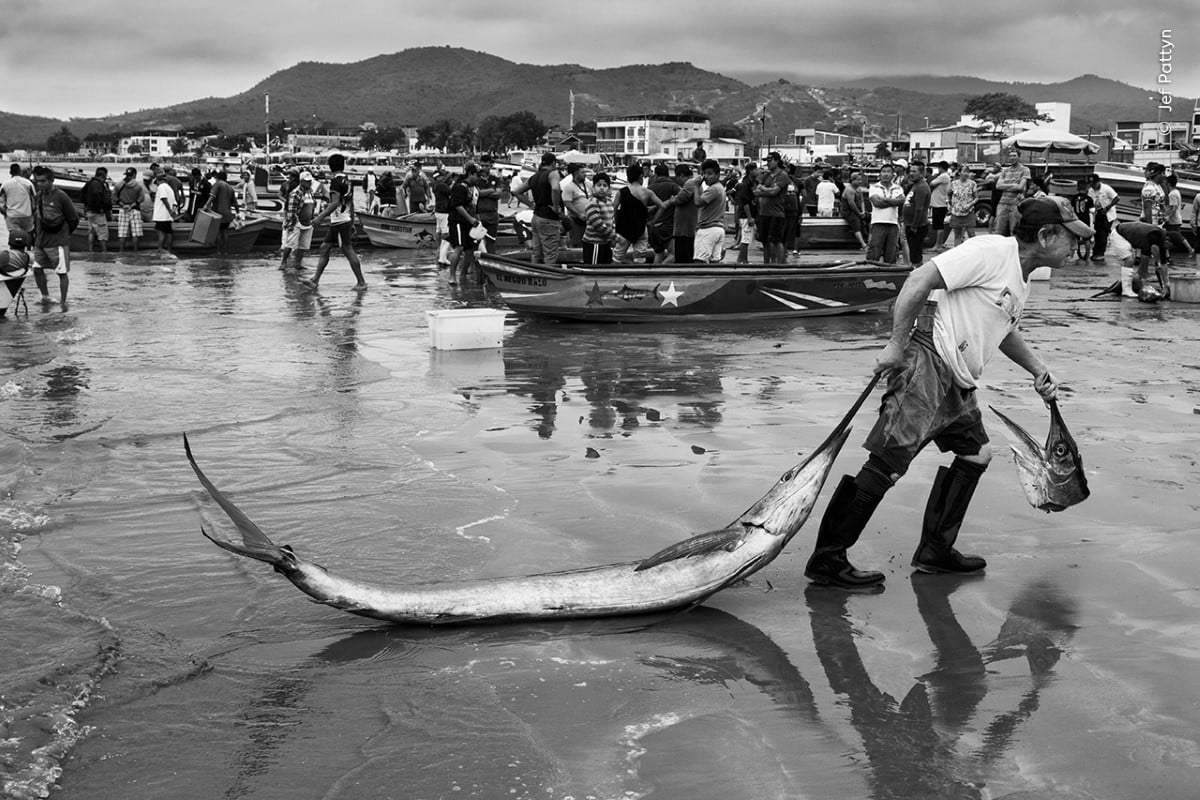
“Prize catch” by Jef Pattyn, Belgium/the Netherlands. Highly commended, Oceans: The Bigger Picture.
Location: Puerto López, Manabí Province, Ecuador
“Jef Pattyn watches as an artisan fisher drags a sailfish across the beach.
Jef had spent days watching fishers bring their catch to shore surrounded by birds trying to get their share. The fish were prepared at sea then loaded onto trucks early in the morning when this photograph was taken. Artisan fishing provides vital employment opportunities for people living around Ecuador’s Eastern Pacific waters. This is small in scale compared to the industrial-scale fishing undertaken by international fleets. However, artisan fishing does still have an impact as marine mammals can be entangled in nets.”
The winners will be announced on October 10, with the London exhibition to open three days later.
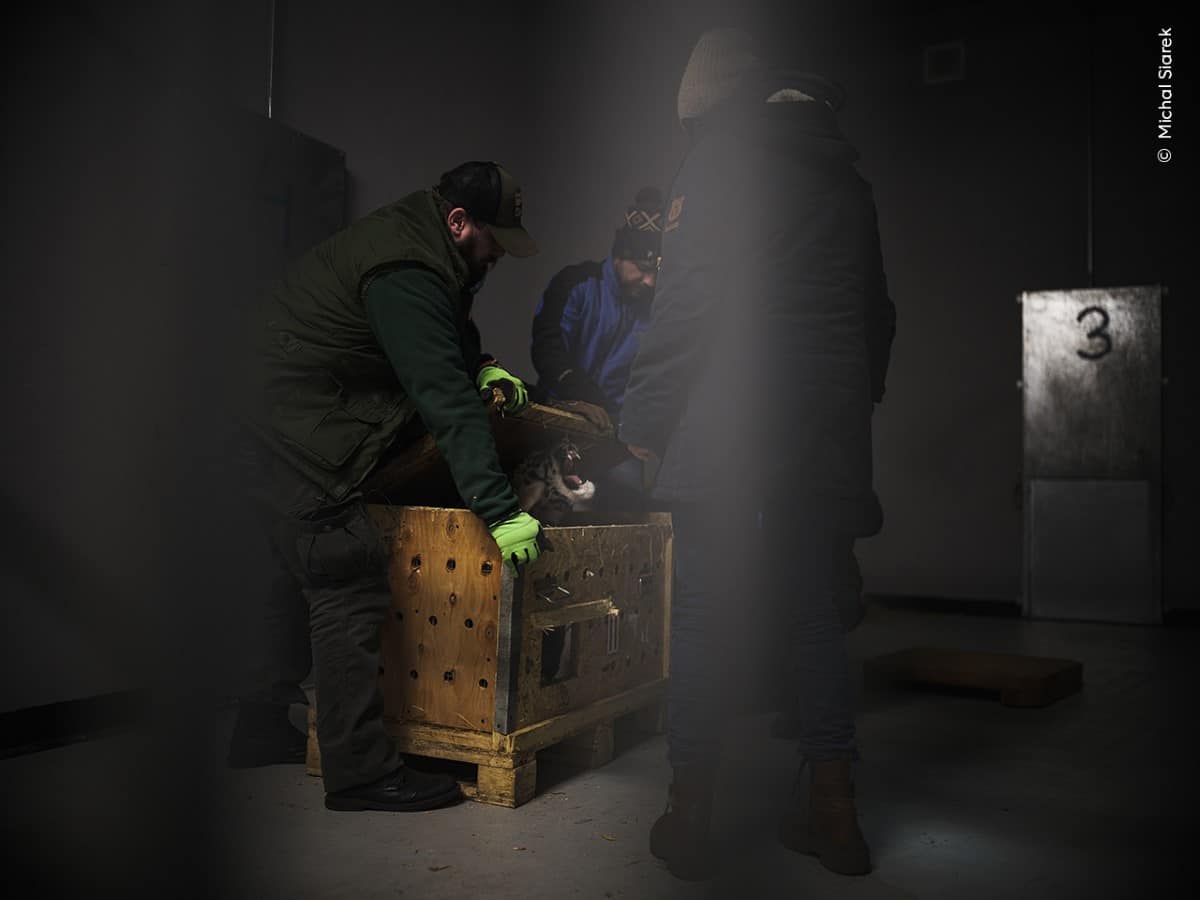
“War cub” by Michał Siarek, Poland. Highly commended, Photojournalism.
Location: Poznań Zoo, Poznań, Poland
“Michał Siarek records the moment a team from Poznań Zoo opens a crate to check on an evacuated tiger cub.
Michał documented efforts to evacuate animals, including wild animals in private ownership, such as tigers, from across war-torn Ukraine. ‘That night changed me,’ he says. ‘Hearing the cry of a lion still in the truck made me decide to help with the next evacuation run.’
Many of the animals were rescued from fighting hotspots in eastern Ukraine in 2022. At the Polish border, the animals were re-crated and rushed to Poznań Zoo, then on to sanctuaries in Europe. More than 200 animals have since been saved.”
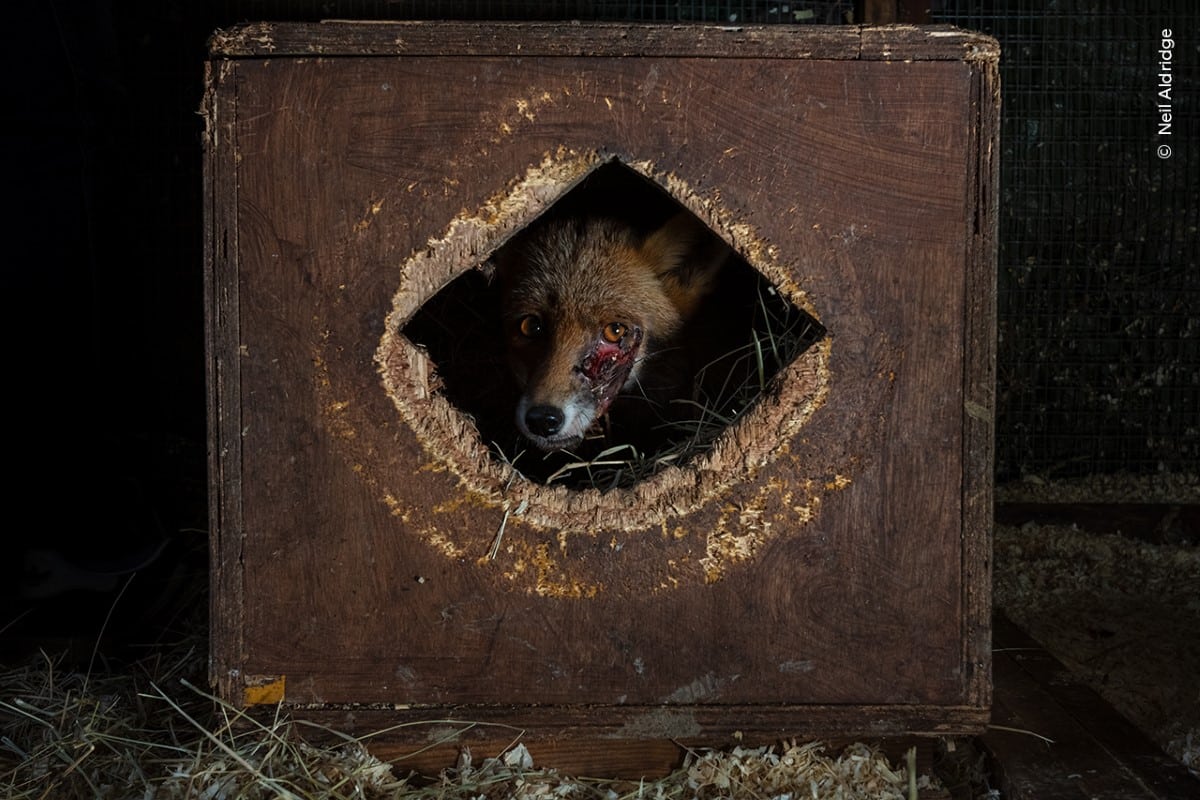
“The face of the persecuted” by Neil Aldridge, South Africa. Highly commended, Photojournalism.
Location: Kent, England, UK
“Neil Aldridge highlights the injuries sustained by a fox – most likely caused by dogs.
Neil framed this fox’s permanently exposed teeth and eye as it peered out from its makeshift den in a rehabilitation center. This image is part of Neil’s nine-year project photographing the complex relationship the British have with the red fox. Since 2005 in England and Wales it has been illegal to poison foxes, block or destroy foxholes, or use dogs to hunt them. The injuries suffered by this animal were likely inflicted by dogs illegally sent into the fox’s den to flush it out.”
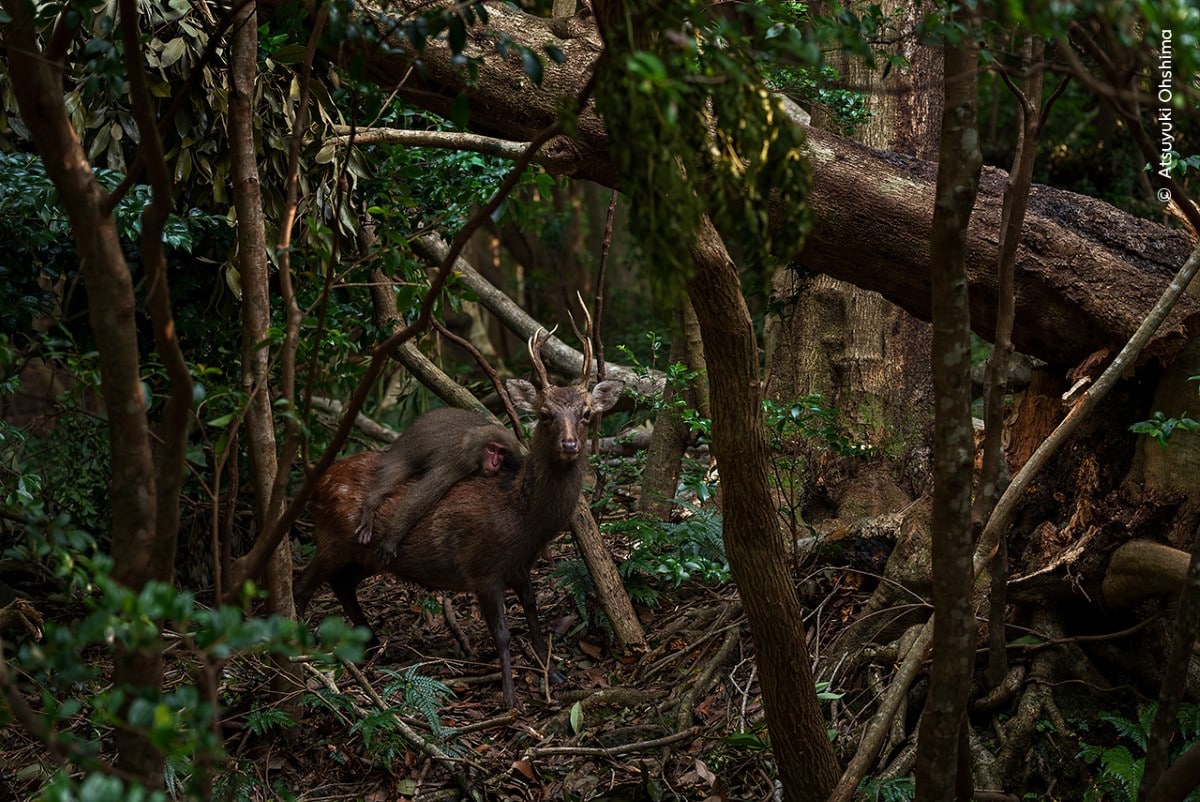
“Forest rodeo” by Atsuyuki Ohshima, Japan. Highly commended, Behaviour: Mammals.
Location: Yakushima, Kagoshima, Japan
“Atsuyuki Ohshima quickly frames an unusual interaction as a macaque jumps on a deer.
A sudden movement behind the sika stag caught Atsuyuki’s eye. In an instant – using a tree as a springboard – a young Yakushima macaque jumped onto the deer’s back. Rodeo-riding of deer by the monkeys of Yakushima Island is rare, but not unheard of. Young male macaques have been seen clinging to female deer and trying to mate with them. In this case, however, the macaque was a young female, appearing just to be enjoying a free ride.”
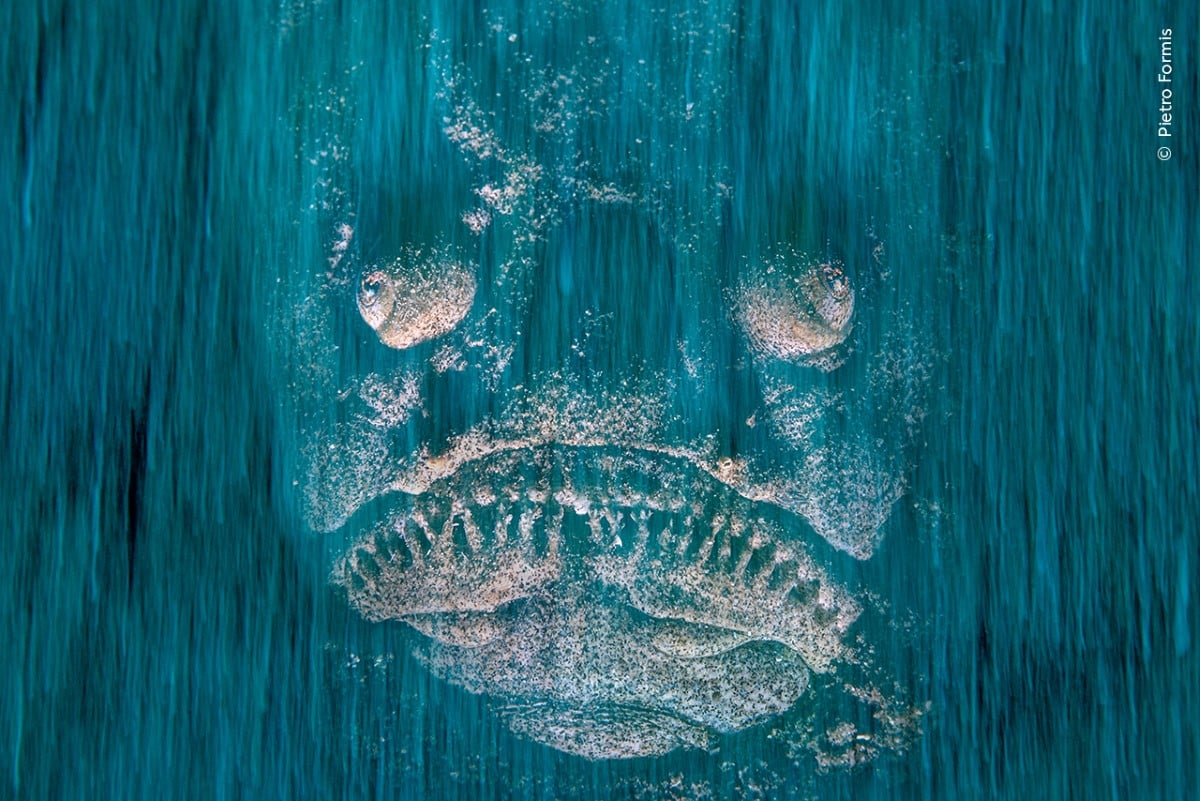
“Death in waiting” by Pietro Formis, Italy. Highly commended, Animal Portraits.
Location: Rijeka, Croatia
“Pietro Formis discovers a Mediterranean stargazer peering through the sandy floor in coastal waters.
Pietro approached the stargazer with care so as not to disturb it. Combining the concentrated light from the flash with a slow shutter speed and deliberate movement from his camera, Pietro presents the stargazer lit through a curtain of turquoise water.
The stargazer is an ambush predator. It buries itself in the sand by wriggling its body until it is invisible except for its eyes and teeth, then it lies in wait for small fish and invertebrates. Its coastal habitat is under pressure from erosion and pollution, and it is often caught as bycatch.”
